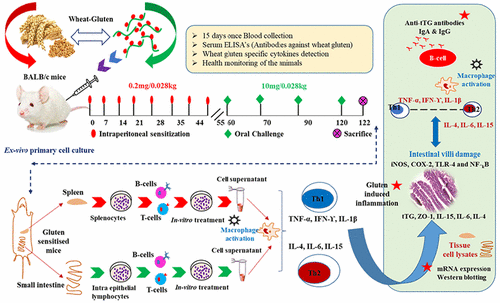当前位置:
X-MOL 学术
›
J. Proteome Res.
›
论文详情
Our official English website, www.x-mol.net, welcomes your feedback! (Note: you will need to create a separate account there.)
Antigen-Specific Gut Inflammation and Systemic Immune Responses Induced by Prolonging Wheat Gluten Sensitization in BALB/c Murine Model
Journal of Proteome Research ( IF 4.4 ) Pub Date : 2017-09-11 00:00:00 , DOI: 10.1021/acs.jproteome.7b00199 M. Vijaykrishnaraj 1 , B. V. Mohan Kumar 1 , S. P. Muthukumar 1 , Nawneet K. Kurrey 1 , P. Prabhasankar 1
Journal of Proteome Research ( IF 4.4 ) Pub Date : 2017-09-11 00:00:00 , DOI: 10.1021/acs.jproteome.7b00199 M. Vijaykrishnaraj 1 , B. V. Mohan Kumar 1 , S. P. Muthukumar 1 , Nawneet K. Kurrey 1 , P. Prabhasankar 1
Affiliation

|
Gluten-related diseases such as wheat allergy, celiac disease, and gluten intolerance are widespread around the globe to genetically predisposed individuals. The present study aims to develop a wheat-gluten induced BALB/c murine model for addressing wheat-gluten related disorders by sensitizing the wheat gluten through the route of intraperitoneal and oral challenge in prolonged days. During the sensitization, the sera were collected for specific antigliadin antibodies response and proinflammatory markers quantification. Ex vivo primary cells and organs were collected for subsequent analysis of inflammatory profile. Prolonging sensitization of gluten can moderate the antigen-specific inflammatory markers such as IL-1β, IL-4, IL-15, IL-6, IFN-γ and TNF-α levels in mice sera. However, ex vivo primary cells of splenocytes (SPLs) and intestinal epithelial lymphocytes (IELs) significantly increased the IL-6, IL-15, IL-1β, and IL-4 levels in G+ (gliadin and gluten) treated cells. Histopathology staining of jejunum sections indicates enterocyte degeneration in the apical part of villi and damage of tight junctions in G+ (gliadin and gluten) sensitized murine model. Immunohistochemistry of embedded jejunum sections showed significant expression of positive cells of IL-15, tTG and IL-4 in G+ sensitized murine model. In contrast, all markers of gluten-related disorders are expressed exclusively such as tTG, ZO-1, IL-15, IL-6, IL-4, and intestinal inflammation was mediated by iNOS, COX-2, TLR-4 and NF-kBp50 signaling mechanism in G+ sensitized mice.
中文翻译:

BALB / c鼠模型中延长小麦麸质敏化作用诱导的抗原特异性肠道炎症和全身免疫反应
与谷类相关的疾病,例如小麦过敏,腹腔疾病和面筋不耐症,在全球范围内普遍存在于遗传易感人群。本研究旨在通过长时间的腹膜内和口服刺激途径使小麦面筋致敏,从而开发一种小麦面筋诱导的BALB / c鼠模型,以解决与小麦面筋相关的疾病。在敏化过程中,收集血清用于特异性抗麦醇溶蛋白抗体反应和促炎标记物定量。收集离体的原代细胞和器官用于随后的炎性分析。延长的面筋敏化作用可以减轻小鼠血清中的抗原特异性炎症标志物,例如IL-1β,IL-4,IL-15,IL-6,IFN-γ和TNF-α水平。然而,脾细胞(SPL)和肠上皮淋巴细胞(IEL)的离体原代细胞显着增加了经G +(麦醇溶蛋白和谷蛋白)处理的细胞的IL-6,IL-15,IL-1β和IL-4水平。空肠切片的组织病理学染色表明,在G +(麦醇溶蛋白和谷蛋白)致敏的小鼠模型中,绒毛的顶端部分肠细胞变性,并且紧密连接受损。埋入的空肠切片的免疫组织化学显示在G +致敏的小鼠模型中IL-15,tTG和IL-4的阳性细胞显着表达。相反,所有与麸质有关的疾病的标志物仅表达,例如tTG,ZO-1,IL-15,IL-6,IL-4,而肠道炎症则由iNOS,COX-2,TLR-4和NF介导。 -- 空肠切片的组织病理学染色表明,在G +(麦醇溶蛋白和谷蛋白)致敏的小鼠模型中,绒毛的顶端部分肠细胞变性,并且紧密连接受损。埋入的空肠切片的免疫组织化学显示在G +致敏的小鼠模型中IL-15,tTG和IL-4的阳性细胞显着表达。相反,所有与麸质有关的疾病的标志物都仅表达,例如tTG,ZO-1,IL-15,IL-6,IL-4,而肠道炎症是由iNOS,COX-2,TLR-4和NF介导的-- 空肠切片的组织病理学染色表明,在G +(麦醇溶蛋白和谷蛋白)致敏的小鼠模型中,绒毛的顶端部分肠细胞变性,并且紧密连接受损。埋入的空肠切片的免疫组织化学显示在G +致敏的小鼠模型中IL-15,tTG和IL-4的阳性细胞显着表达。相反,所有与麸质有关的疾病的标志物都仅表达,例如tTG,ZO-1,IL-15,IL-6,IL-4,而肠道炎症是由iNOS,COX-2,TLR-4和NF介导的--G +致敏小鼠中的k Bp50信号传导机制。
更新日期:2017-09-11
中文翻译:

BALB / c鼠模型中延长小麦麸质敏化作用诱导的抗原特异性肠道炎症和全身免疫反应
与谷类相关的疾病,例如小麦过敏,腹腔疾病和面筋不耐症,在全球范围内普遍存在于遗传易感人群。本研究旨在通过长时间的腹膜内和口服刺激途径使小麦面筋致敏,从而开发一种小麦面筋诱导的BALB / c鼠模型,以解决与小麦面筋相关的疾病。在敏化过程中,收集血清用于特异性抗麦醇溶蛋白抗体反应和促炎标记物定量。收集离体的原代细胞和器官用于随后的炎性分析。延长的面筋敏化作用可以减轻小鼠血清中的抗原特异性炎症标志物,例如IL-1β,IL-4,IL-15,IL-6,IFN-γ和TNF-α水平。然而,脾细胞(SPL)和肠上皮淋巴细胞(IEL)的离体原代细胞显着增加了经G +(麦醇溶蛋白和谷蛋白)处理的细胞的IL-6,IL-15,IL-1β和IL-4水平。空肠切片的组织病理学染色表明,在G +(麦醇溶蛋白和谷蛋白)致敏的小鼠模型中,绒毛的顶端部分肠细胞变性,并且紧密连接受损。埋入的空肠切片的免疫组织化学显示在G +致敏的小鼠模型中IL-15,tTG和IL-4的阳性细胞显着表达。相反,所有与麸质有关的疾病的标志物仅表达,例如tTG,ZO-1,IL-15,IL-6,IL-4,而肠道炎症则由iNOS,COX-2,TLR-4和NF介导。 -- 空肠切片的组织病理学染色表明,在G +(麦醇溶蛋白和谷蛋白)致敏的小鼠模型中,绒毛的顶端部分肠细胞变性,并且紧密连接受损。埋入的空肠切片的免疫组织化学显示在G +致敏的小鼠模型中IL-15,tTG和IL-4的阳性细胞显着表达。相反,所有与麸质有关的疾病的标志物都仅表达,例如tTG,ZO-1,IL-15,IL-6,IL-4,而肠道炎症是由iNOS,COX-2,TLR-4和NF介导的-- 空肠切片的组织病理学染色表明,在G +(麦醇溶蛋白和谷蛋白)致敏的小鼠模型中,绒毛的顶端部分肠细胞变性,并且紧密连接受损。埋入的空肠切片的免疫组织化学显示在G +致敏的小鼠模型中IL-15,tTG和IL-4的阳性细胞显着表达。相反,所有与麸质有关的疾病的标志物都仅表达,例如tTG,ZO-1,IL-15,IL-6,IL-4,而肠道炎症是由iNOS,COX-2,TLR-4和NF介导的--G +致敏小鼠中的k Bp50信号传导机制。

























 京公网安备 11010802027423号
京公网安备 11010802027423号